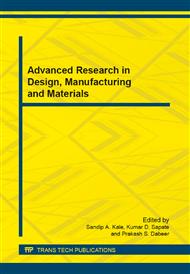p.29
p.35
p.41
p.51
p.59
p.65
p.71
p.77
p.83
Parametric FEA Analysis of Double Flexural Manipulator for Precision Application
Abstract:
A Flexural mechanism uses flexibility of material for desired motion objectives. As compared rigid-body mechanisms where actuations are applied at the joints connecting rigid links, the manipulation of the Flexural mechanism relies on the deflection of internal flexible members. Flexural mechanisms have no relative moving parts (and thus involve no wear, backlash, noise and lubrication), are relatively compact in design as compared to rigid link mechanism. Double Flexural Manipulator (DFM) is basic building block for planar flexural mechanism. This paper explains working principle of DFM and its parametric modelling. DFM has three basic parameters which decides range of motion, actuator requirement (Peak force and continuous force). In this paper Parametric FEA analysis is carried on DFM and verified with Analytical Model. This parametric modelling can be further used for designing and developing a flexural mechanism for precision applications.
Info:
Periodical:
Pages:
59-64
Citation:
Online since:
August 2014
Authors:
Price:
Сopyright:
© 2014 Trans Tech Publications Ltd. All Rights Reserved
Share:
Citation:


